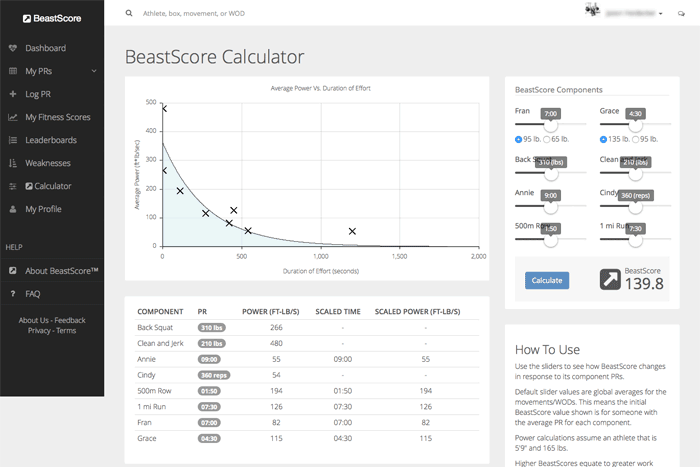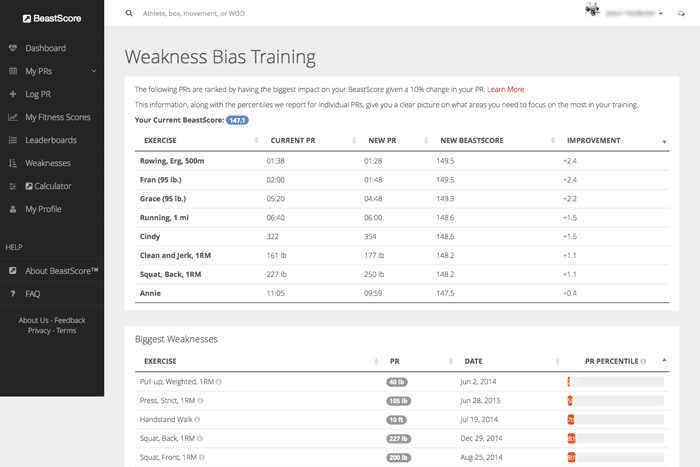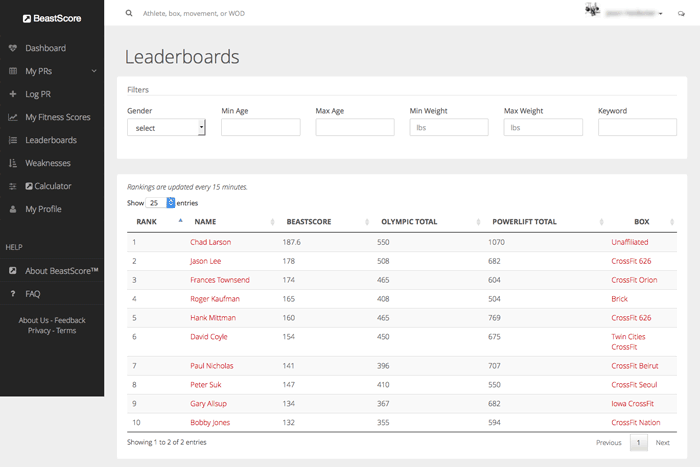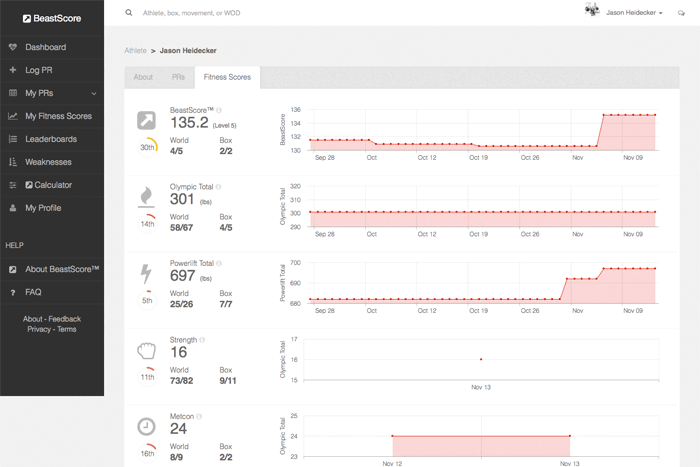Athletes are #1
It’s been one year since the inception of BeastScore. By nature, BeastScore is a tool that serves not only athletes, but coaches, program directors, teams, and competitions as well. As BeastScore has grown as a company and as a community, our focus has occasionally shifted between these various types of customers. Today, we’re announcing that BeastScore is making athletes our number-one priority, and we’re fully dedicating ourselves to helping athletes quantify and improve their fitness.
In light of our renewed focus on supporting athletes, we’ve made significant changes to the BeastScore service:
- We’ve implemented a completely new BeastScore algorithm based on a new suite of 1 RM and WOD components that measures fitness as an athlete’s total work capacity
- We’re introducing Weakness Bias Training features for athletes who are tired of training in the dark and who want to know what their biggest weaknesses are and what types of training will provide the greatest leaps in their fitness (i.e. improve their BeastScores and other fitness scores).
- Last but not least, BeastScore.com officially has a slogan: “Take your fitness to the next level™”, which is what we aim to do for all athletes. Quantify, measure, and improve is our mantra — quantify fitness through BeastScore and other fitness scores, then identify, measure, and attack weakness to improve fitness.
The New BeastScore
The original BeastScore algorithm was developed by statisticians and mathematicians using PR data and competitions results from thousands of athletes. Higher BeastScores meant a higher likelihood of placing higher at competition. The assumption made by this approach (which we now consider flawed) was that better competition results equaled better fitness and athletic development. Of course in some sense this is true as fitter athletes will perform better in competition, but basing a fitness measuring system like BeastScore on competition results is a flawed approach. Competitions need to be fan-friendly, revenue generating, schedule-friendly operations. Under these constraints, competitions cannot be a true and complete representations of fitness.
With the new BeastScore we are measuring fitness as total work capacity, which is calculated using power vs. time graphs like these:
These graphs are made using power calculations (the Xs on the graph) for various exercises using an athlete’s personal records. The area under the P-T curve is equal to work capacity which we call BeastScore. BeastScore 101 has all the details on how BeastScores are calculated.
BeastScore is the world’s first and only service to calculate fitness in terms of work capacity.
After analyzing the power output of more than 100 movements, lifts, and WODs across many modal and time domains we selected the following components: clean & jerk, back squat, 500m row, 1 mile run, Fran, Grace, Annie, and Cindy. By logging scores for these eight components, users of our site can get a BeastScore and be placed on the leaderboards.
We are really excited about the new BeastScore and the many advantages it has over its previous form. For example, the old BeastScore was a number between 1 and 100. Having an upper bound meant losing the ability to see how athletes’ fitness as a community was changing over time. The best athletes always had BeastScores in the 90s. But with the new BeastScore, there is no upper bound so we can see how the community as a whole is getting fitter. Rich Froning and his cohorts have BeastScores ranging from 210 to 245. How exciting will it be to compare this generation to the average BeastScore of the Games athletes in 20 years!? Froning, Thorisdottir, CLB, and Fraser are beasts, but don’t be surprised if they look like tennis players from the 1920s compared to what we see in the future!
We are also debuting several other fitness scores with corresponding leaderboards that delve deeper into more focused areas of fitness and will be continually adding more in an effort to provide as much insight into an athlete’s fitness as possible.
Weakness Bias Training
Measuring fitness and identifying weaknesses are two sides of the same coin. BeastScore and other fitness scores are used to quantify fitness. The following features are used to identify and squash weaknesses:
- Percentiles for each personal record so athletes know where they stand on every movement
- A prioritized list of what improvements would have the greatest impact on BeastScore. For example: “A X% (12 lb.) improvement in your 1RM deadlift will improve your BeastScore by Y.”
- A graphical and easy to use calculator that allows athletes to discover on their own the relationship between their 1 RM and WOD scores and their BeastScores.
Essentially, BeastScore.com is an athlete’s best friend when it comes to improving fitness.
Membership Changes
In addition to the changes to BeastScore and the new features we’ve implemented, we have switched to a paid-member only site. This will ensure a reliable and feature-rich site and also eliminate the need to display ads.
All existing members can upgrade their free accounts to paid memberships for 50 percent off. All members will be receiving a coupon code via email. If the code does not arrive, members can request one from Customer Support.
Quick Tour
Below are some screenshots from the new site.








